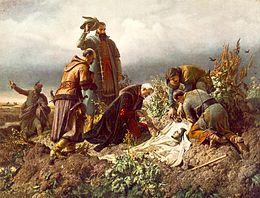The Medieval Kingdom of Hungary (1000-1526)
Foundation
Grand Prince Vajk of the Árpád dynasty founded the Kingdom of Hungary in the year 1000 when he was crowned as King Stephen (István) with recognition from Pope Sylvester II. Esztergom (modern-day northern Hungary) and Székesfehérvár (modern-day central Hungary) initially served as the capitals of the Kingdom of Hungary.
The Western Kingdom
Vajk and his second cousin, Koppány, fought for leadership over the Principality of Hungary following the death of Vajk’s father, Grand Prince Géza, in the year 997. Vajk had been baptized into the Latin Church with the Christian name Stephen, whereas Koppány had remained pagan. Vajk’s defeat of Koppány in battle in 998 with the help of Bavarian knights secured his claim to succession as ruler of the principality and the orientation of the incipient Kingdom of Hungary toward Rome and the Holy Roman Empire.
The Holy Crown
The Holy Crown (Szent Korona) is the main symbol of Hungarian statehood and the Hungarian nation. For centuries it was assumed that the Szent Korona in its present form was used to crown King Stephen and all subsequent monarchs of the realm. However, 20th-century research showed that the crown has existed in its present form only since around the year 1200. The crown consists of two parts—the lower Greek Crown from Byzantium and the upper Latin Crown presumed to be from Rome. Elements from the latter portion of the crown may have been part of that used in the coronation of Stephen.
Kings from the Árpád Dynasty (1000-1301)
Hungarian Kings from the House of Árpád ruled the Kingdom of Hungary for the first three-hundred years of its existence, from Stephen I beginning in 1000 through Andrew (András) III ending in 1301. Two kings from the Árpád dynasty were canonized as saints in the Roman Catholic Church: King Stephen I (1000-1038); and King Ladislaus (László) I (1077-1095). King Stephen was also glorified as a saint in the Eastern Orthodox Church.
Personal Union with the Kingdom of Croatia (1091)
The Kingdom of Hungary and the Kingdom of Croatia were united in a personal union under King Ladislaus (László) I of the House of Árpád in 1091. The monarchs of the Kingdom of Hungary, whether Hungarian or foreign, continued to serve as kings of the Kingdom of Croatia until the latter joined the Kingdom of Serbs, Croats and Slovenes in 1918.
The Mongol Invasion (1241-1242)
The Mongols under Batu Khan invaded eastern Europe, including Hungary, during the dynamic westward expansion of the Mongol Empire in the first half of the 13th century. Mongol forces destroyed the armies of King Béla IV at the Battle of Mohi in modern-day northeastern Hungary in 1241 and ravaged the Kingdom of Hungary over the following year. Batu Khan withdrew his forces from Hungary in 1242 following the death of the supreme khan in order to stake his claim to leadership over the entire Mongol Empire. King Béla IV, who had taken refuge on various islands in the Adriatic Sea off the coast of Dalmatia during the Mongol invasion, oversaw the rebuilding of the Kingdom of Hungary following the withdrawal of the Mongols, thus earning himself the title of Second Founder of the Homeland (második honalapító) after King Stephen. Béla IV began building Buda Castle shortly after the Mongol invasion and moved the capital of the Kingdom of Hungary to Buda in 1256.
Kings from Foreign Dynasties (1310-1526)
Naples-born Charles I of the House of Anjou acceded to the throne of the Kingdom of Hungary after a nine-year struggle for succession following the extinction of the House of Árpád in 1301. His claim to royal succession was based on the fact that his paternal grandmother was the daughter of Árpád-dynasty King Stephen (István) V. The official coronation of Charles I in 1310 initiated a 216-year period in which kings from the foreign houses of Anjou, Luxembourg, Habsburg and Jagiellon provided the monarchs of the Kingdom of Hungary, with the exception of the 32-year reign of King Matthias (Mátyás) Corvinus (1458–1490) from the Hungarian House of Hunyadi.
–
End of the Medieval Kingdom of Hungary: the Battle of Mohács (1526)
In 1526 military forces from the Ottoman Empire under the leadership of Sultan Suleiman I annihilated the armies of the Kingdom of Hungary under King Louis II at the Battle of Mohács in modern-day southern Hungary. King Louis II drowned in a creek after falling off his horse wearing heavy armor during the retreat of what remained of his army. Following the Battle of Mohács, the Turks gradually incorporated the central wedge of the Kingdom of Hungary, including Budapest, directly into the Ottoman Empire and transformed the eastern part of the kingdom into a semi-independent vassal state known as the Principality of Transylvania from the year 1570. Four months after the Battle of Mohács, the brother-in-law of the fallen King Louis II, Archduke of Austria Ferdinand of the House of Habsburg, was crowned King Ferdinand I and incorporated the Kingdom of Hungary into the Habsburg Empire. This marked the beginning of a period of 341 years (1526-1867) during which the House of Habsburg held control over the Kingdom of Hungary.
————————————————-
—
Europe 100 Years after the Foundation of the Kingdom of Hungary




